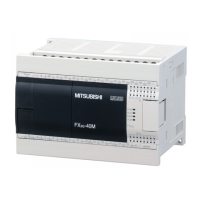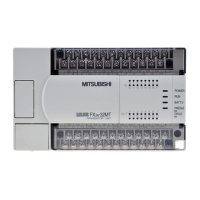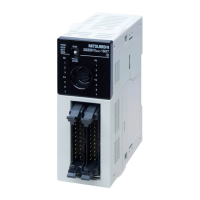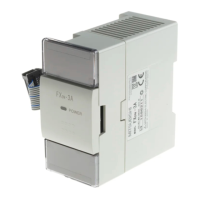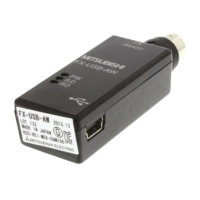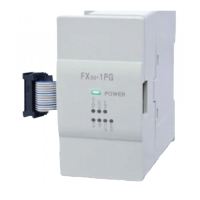K-16
3 Wiring
3.4 Selection of the Resistance Thermometer Sensor
FX
3S
/FX
3G
/FX
3GC
/FX
3U
/FX
3UC
PLC User's Manual - Analog Control Edition
FX3U-4AD-PNK-ADP (4-channel Resistance Thermometer Data Input)
3.4 Selection of the Resistance Thermometer Sensor
Select the Pt1000/Ni1000 (2-wire or 3-wire sensors) resistance thermometer sensor.
3.5 Wiring of the Resistance Thermometer Sensor
Wiring depends on the resistance thermometer sensor type selected. Refer to the following wiring diagrams:
*1. For FX
3S/FX3G/FX3U Series PLC (AC power type), the 24 V DC service power supply is also
available.
*2. When using a 2-wire temperature sensor type, short-circuit the [L -] terminal and the [I -] terminal.
For the lead wire use a 10 Ω resistance or less per line.
*3. Separate the cable of the platinum resistance thermometer sensor from the other power cables or
areas easily affected by inductive noise (of the commercial power, etc.).
3.6 Caution Regarding Wiring
• It is not possible to connect different types of resistance thermometer to 4 channels of PNK-ADP. Be sure
to use the same type of resistance thermometer for all the channels.
3.7 Grounding
Grounding should be performed as stated below.
• The grounding resistance should be 100 Ω or less.
• Independent grounding should be performed for best results.
When independent grounding is not performed, perform "shared grounding" as shown in the following
figure.
→ For details, refer to the User’s Manual - Hardware Edition of the each PLC Series.
• The grounding wire size should be AWG22 to 20 (0.3 to 0.5 mm
2
).
• The grounding point should be close to the PLC, and all grounding wires should be as short as possible.
1M
ch
PNK-ADP
Class-D grounding
+5V
24+
24-
Shield wire
Terminal
block
24V DC
*1
L+, L-, I-, ch: represents the channel number.
3-wire
sensors
type
1M
47k47k
+5V
1M
ch
+5V
1M
47k47k
2-wire
sensors
type
L-
I-
L+
L-
I-
L+
*2
*3
Resistance thermometer
wiring
External power supply
wiring
PLCPLCPLC
Other
equipment
Other
equipment
Other
equipment
Shared grounding
Good condition
Common grounding
Not allowed
Independent grounding
Best condition

